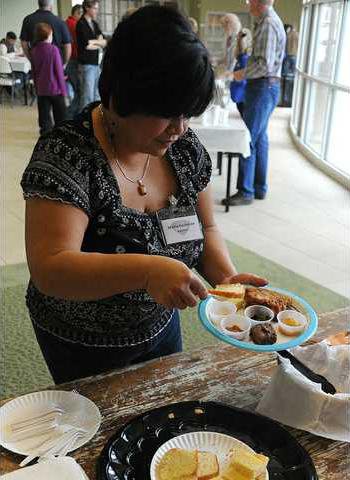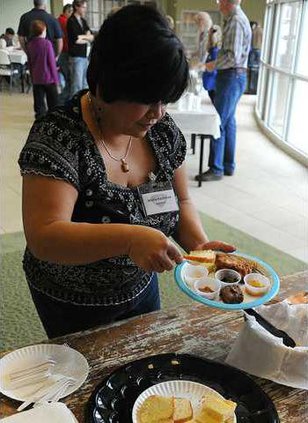For the curious onlookers, as defined by Paula Deen of Food Network fame, modern Southern cooking is defined by butter, butter and more butter. In the early 1900s, lard ruled the day. To help the uninitiated — or the just plain curious — keep up with the ever-evolving cuisine, the Northeast Georgia History Center recently hosted an edible history lesson focused on "The Southern Table." "A definition of what makes food Southern requires some explaining because it means different things to different people," explained the recipe booklet that attendees received. "Although Southern food conjures up different images, down-home Southern cuisine traditionally uses what Southern farms have historically and easily produced." The idea for the event was sparked by "An Irresistible History of Southern Food," a cookbook available in the center’s gift shop. "It covers a lot of cultural and preparation history related to Southern cooking," said Julie Carson, the center’s education and volunteer coordinator. "After reading through it, we got the idea to condense the book into one activity. We started out by trying to provide background on what Southern cooking is, but that was like trying to get a tiger by the tail. It’s a very broad category. "So we decided to narrow it down to corn and pork — foods that are commonly considered Southern and that can be found in some variation in all Southern states." Although in it’s organic state, corn may not seem all that Southern, after a few passes through the grist mill, the ground version is used to create easily recognizable southern dishes like grits and corn-bread. While Southern cooks may have perfected certain dishes, the incorporated ingredients’ roots stretch all over the globe. Black-eyed peas are native to Africa, while the yams that are typically smothered in a sugary syrup on Southern tables are imports from Brazil, Carson says. Collard greens and corn were borrowed from Native American diets. "Most of our Southern foods have roots in English, Native American, African and Scotch-Irish cultures," Carson said. The origins of the foods may vary, but Southern cuisine is united by a common theme. "Recipes of Southern dishes have been passed down from generation to generation — changing with the times when necessary, adapted and improved upon," explains the Southern Table recipe booklet. "Southern cooking epitomized the Southern spirit in that Southerners have always taken what they might have on hand and gone well beyond making do. Turning modest fare into delectable culinary treasures."
Butter, corn, pork define Southern fare
History Center event a showcase of down-home goodness

